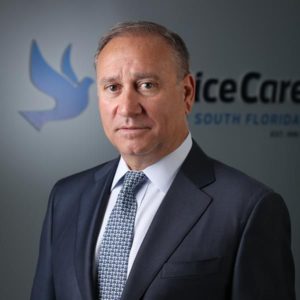Strategies for End-of-Life Conversations During COVID-19

Anna-Gene O’Neal, Division President of Health Care Services, Brookdale Senior Living
End-of-life conversations are difficult, but they’re also an essential aspect of operating a senior care facility.
In the light of the COVID-19 pandemic, these conversations have become even more important. Facilities need to be active in scheduling these discussions, and should be prepared for the challenges that the pandemic can create.
The Current Importance of End-of-Life Conversations
The pandemic has highlighted the importance of end-of-life conversations. Anna-Gene O’Neal, Division President of Health Care Services at Brookdale Senior Living, notes that “A pandemic, such as COVID-19, clearly changes everyone’s risk profile and should be used as a catalyst to visit or revisit end of life conversations. The current spread of the virus is rampant and the healthcare data clearly demonstrate an increased mortality rate for seniors or individuals with underlying health concerns.”
O’Neal advocates for these conversations occurring with regularity, but they should also occur with any changes in physical condition or risk profiles.
Unfortunately, these important conversations are sometimes overlooked. Dr. Ismael Roque-Velasco, President and CEO of OpusCare South Florida, notes that the problem is widespread. “What we’re seeing is a lack of planning by families, by residents, and by facilities,” he notes.
“We’ve conducted several surveys and research on this matter. I think that primary cares are not addressing these conversations enough, and in medical centers, we’ve seen a compliance of 20% on advanced directives. We’re creating an initiative within our palliative care program to educate facilities, physicians’ offices, primary care medical centers, residential facilities, assisted living facilities, and senior care centers on how to have those conversations. By educating staff and professionals, we’ve been able to increase compliance to 80%.”
Tips for a Successful End-of-Life Conversation
Senior care facilities need to reach out and schedule end-of-life conversations to ensure that residents’ and families’ wishes are communicated and articulated, says O’Neil. “First, we need to be willing to schedule discussions. We, as senior living providers, should define who needs to be a part of these meetings; do we have the right audience. This audience may include not only the resident, but also the resident’s healthcare power of attorney, or an even broader group of friends and family members.
“I recommend that a clinician comfortable with understanding the current COVID-19 epidemiology be present in the discussions as well. Clinical questions will likely be discussed as a precursor to framing and ultimately making decisions.”
While end-of-life conversations would traditionally take place in person, COVID-19 restrictions may mean that these conversations are increasingly held via video conference or over the phone. Roque-Velasco notes that his program frequently uses telemedicine by Zoom to connect with and educate families.
“We’ve found that when starting these conversations, the social worker, doctor, or staff need to be professional but also sensitive to the needs of the patient and family, especially when addressing cultural differences. In these times, nothing beats a person-to-person meeting, but when that fails, a good face-to-face through video where you have that relationship where you answer questions can allow you to provide your professional experience to the families.”
O’Neal agrees that it’s ideal for these conversations to take place in person, but that with the limited visitation allowed by the pandemic, facilities can and should use FaceTime and other communication platforms. “It is important to be able to see the non-verbal cues coming from those in the group to ensure that everyone’s views are being heard and valued,” she notes. “A traditional phone call limits this ability. However, if your only option is a traditional phone call, be certain to ask every attendee on the call to share their views. This is critical.”

Dr. Ismael Roque-Velasco, CEO, Opus Care South Florida
Strategies to Reassure Families and Residents
This is a time of uncertainty, and policies and plans can change rapidly. As such, it’s important to frame the conversation to reassure the family and resident. O’Neal suggests opening the conversation with the following statements to reassure all participants:
- Explain the facility is taking the necessary precautions and preventive measures to avoid the spread of COVID-19.
- Acknowledge that data has demonstrated the prevalence of asymptomatic carriers, and as a result, prevention strategies are strong but not perfect.
- Acknowledge the fear associated with the pandemic.
- Take time to listen to the residents and their families.
“One would be surprised, but the discussion might just shift automatically without any further need to bridge,” explains O’Neal. “If not, an easy way to frame the conversation is to focus on how we all want to live, not how we want to die, should we be diagnosed with and develop complications from COVID-19 or any potentially terminal disease.”
Remember that these conversations can take many forms, O’Neal suggests. Ethical issues and family conflicts can arise. “It is critical that those leading and facilitating these discussions have adequate training to manage these complex but critical communications,” she notes.
For additional guidance on end-of-life conversations during the pandemic, you can access the Coalition for Compassionate Care of California’s COVID Conversations Toolbox. This toolbox contains resources to support healthcare providers and consumers during the pandemic.

Paige Cerulli is a contributing writer to i Advance Senior Care.
Related Articles
Topics: Administration , Departments , Featured Articles , Leadership , Training











